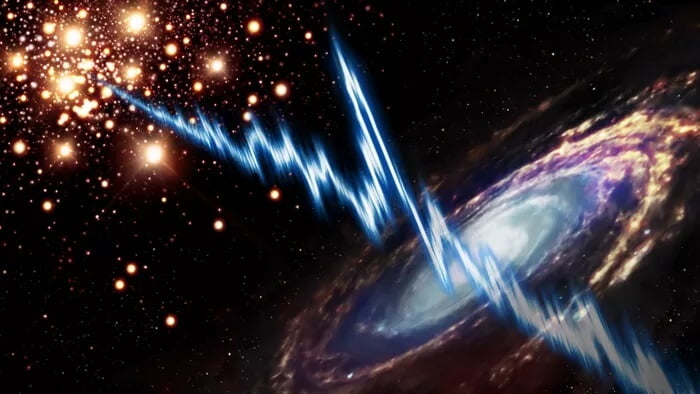
A New FRB Signal Has Buzzed Nearly 2,000 Times In Just Two Months, Raising A Mystery
Something isn't adding up.
By: Mike McRae | Science Alert
We have detected a strange new signal from across the chasm of time and space.
A repeating fast radio burst source detected last year was recorded spitting out a whopping 1,863 bursts over 82 hours, amid a total of 91 hours of observation.
This hyperactive behaviour has allowed scientists to characterize not just the galaxy that hosts the source and its distance from us, but also what the source is.
The object, named FRB 20201124A, was detected with the Five-hundred-meter Aperture Spherical radio Telescope (FAST) in China and described in a new paper led by astronomer Heng Xu of Peking University in China.
So far most evidence points to a magnetar – a neutron star with extraordinarily strong magnetic fields – as a source of FRB emissions like this.
If FRB 20201124A is indeed from one of these wild cosmic beasts, it’s looking like an unusual specimen.
“These observations brought us back to the drawing board,” says astrophysicist Bing Zhang of the University of Nevada, Las Vegas.
“It is clear that FRBs are more mysterious than what we have imagined. More multi-wavelength observational campaigns are needed to further unveil the nature of these objects.”
“Astronauts of The Third Reich” Travelled In Time: From 1943 To 1990
Fast radio bursts have been a source of puzzlement to astronomers since they were first discovered 15 years ago, in archival data dating back to 2001: A spike of incredibly powerful radio emission lasting just an eye blink of time.
Since then, many more have been detected: millisecond-duration bursts of radio waves, discharging in that moment as much power as 500 million Suns.
Most on record have erupted just the once, making them challenging to study (let alone understand). A scant handful have been detected repeating, which has helped scientists at least trace them to host galaxies.
Then, in 2020, a breakthrough. For the first time, a fast radio burst was detected within the Milky Way – leading astrophysicists to trace the phenomenon to magnetar activity.
This most recent extraordinary FRB example is another example of a rare repeater. In less than two months of observation, FRB 20201124A has given astronomers the biggest sample of fast radio burst data with polarization than any other FRB source.
Polarization refers to the orientation of light waves in three-dimensional space. By examining how much that orientation has changed since the light departed its source, scientists can understand the environment through which it has passed. Strong polarization suggests a powerful magnetic environment, for example.
Based on the wealth of data delivered by FRB 20201124A, astronomers were able to infer that the source is a magnetar.
But there was something strange. The way the polarization changed over time suggested that the strength of the magnetic field and density of particles around the magnetar were fluctuating.
“I equate it to filming a movie of the surroundings of an FRB source, and our film revealed a complex, dynamically evolving, magnetized environment that was never imagined before,” Zhang explains.
“Such an environment is not straightforwardly expected for an isolated magnetar. Something else might be in the vicinity of the FRB engine, possibly a binary companion.”
That companion, the data suggest, could be a hot, blue Be-type star, which are often found in companions with neutron stars. The evidence for this was laid out in a separate paper, led by astronomer Fayin Wang of Nanjing University in China.
But there was something else peculiar, too.
As a type of neutron star, magnetars are the collapsed cores of massive stars that, having run out of fuel to burn and provide outward pressure, collapse under their own gravity.
Such stars burn through their fuel quickly, and have short lives, expelling their outer material in a supernova as the core collapses.
Because their lives are so brief, these young magnetars are thought to be found in regions where star formation is still occurring. Stars live their short lives and die, creating more clouds of material to give birth to more stars. It’s a beautiful cosmic circle of life.
But FRB 20201124A was found in a galaxy a lot like the Milky Way. There’s not a lot of star formation going on here at home, so there shouldn’t be a baby boom of stars near our unusual new FRB friend either.
FRB 20201124A isn’t the only FRB source to be found in a galaxy relatively devoid of star formation, though.
The growing count suggests that there’s some vital piece of information we may be missing, some hole in our understanding of FRB magnetars, how they form, and the locations in which they reside.
But the characterization of the source means we have a new place to look for answers. The work of Wang and his colleagues suggests that neutron star-Be star binaries might be one of the best places to look for fast radio burst-like signals.
The two papers have been published in Nature and Nature Communications.
* * *
NEXT UP!
Iraqi Stargates: The Gulf Wars & Alien Future Tech
In the last free decades, Iraq has had the distinction of being in a war with the USA and its allies twice. The First Gulf War officially started on August 2 with the Iraqi invasion of Kuwait which led to the United States launching Operation Desert Storm on January 17, 1991.
* * *
More on Alien Tech: Does The Real Element 115 Have A Connection With UFOs?
Enjoyed it? Please take a moment to show your support for Collective Spark.
We’d love to hear from you! If you have a comment about this article or if you have a tip for a future Collective Spark Story please let us know below in the comment section.
